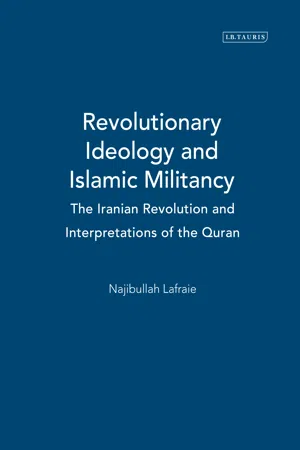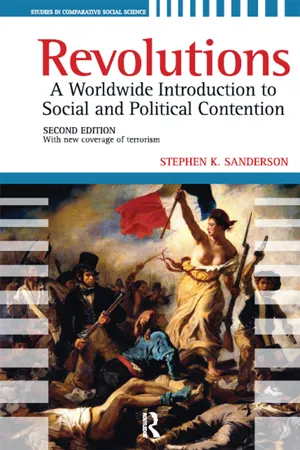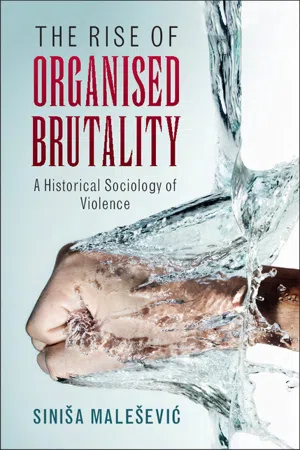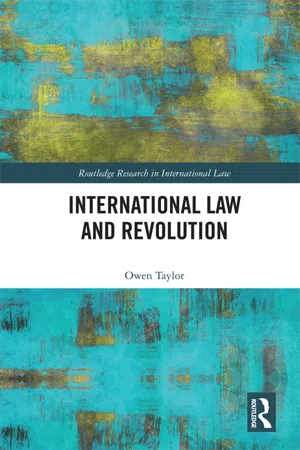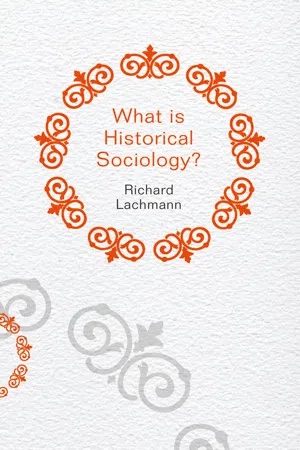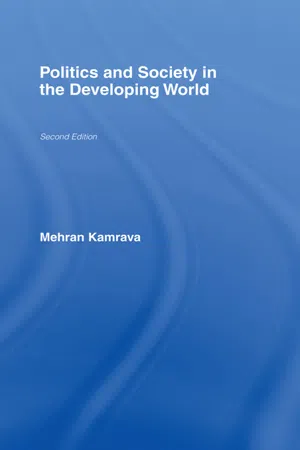History
Revolution
A revolution is a fundamental and often sudden change in the political, social, or economic structure of a society, typically resulting in a shift in power from one group to another. Revolutions can be sparked by various factors such as inequality, oppression, or a desire for greater freedom and rights. They often involve mass movements, protests, and sometimes armed conflict.
Written by Perlego with AI-assistance
Related key terms
1 of 5
10 Key excerpts on "Revolution"
- eBook - PDF
Revolutionary Ideology and Islamic Militancy
The Iranian Revolution and Interpretations of the Quran
- Najibullah Lafraie(Author)
- 2009(Publication Date)
- I.B. Tauris(Publisher)
In this section, I first provide a selection of definitions of “Revolution” as it is applied to political change in the state, and then specify the definition to be used in this text. Revolution has been variously defined as: a forcible intervention, either to replace governments, or to change the process of government (Peter Calvert). a sudden and violent overthrow of an established political order (Carl Friedrich). that kind of social change which occurs when the basic institutional values of social order are rejected and new values accepted (Rex Hopper). an insurrection, an act of violence by which one class overthrows another (Mao Zedong). a sweeping, fundamental change in political organization, social structure, economic property control and the dominant myth of social order, thus indicating a major break in the continuing of a development (Sigmund Newman). Only when [the] pathos of novelty is present and where novelty is connected with the idea of freedom are we entitled to speak of Revolution (Hanneh Arendt). Social Revolutions … are rapid, basic transformations of a country’s state and class structures, and its dominant ideology (Theda Skocpol, 1982). R EVOLUTIONARY I DEOLOGY AND I SLAMIC M ILITANCY 12 Political Revolution is the transformation of power [which] aims to change the style of politics based on the state’s monopoly of armed violence. It aims at the dissolution of the state (Krishan Kumar). A Revolution is a fundamental change of social structure brought about in a short period of time (Johan Galtung). The common element in all these definitions is the idea of change. But what kind of change characterizes a Revolution? Responses vary, some being so broad as to include even coups; and others so narrow that they exclude some widely recognized Revolutions. - eBook - ePub
Revolutions
A Worldwide Introduction to Political and Social Change
- Stephen K. Sanderson(Author)
- 2015(Publication Date)
- Routledge(Publisher)
Chapter OneThe Nature of RevolutionsUnderstanding RevolutionsWhat is a Revolution? Wilbert Moore (1963), a well-known student of social change, thinks of Revolutions as a form of change that involves violence, that engages a large portion of the population, and that produces a transformation of the overall structure of government. John Dunn (1972) sees Revolutions as a form of change that is massive, violent, and rapid. Samuel Huntington (1968:264), in a definition that has been favorably endorsed by many, conceives of a Revolution as a “rapid, fundamental, and violent domestic change in the dominant values and myths of a society, in its political institutions, social structure, leadership, and government activity and policies.”A. S. Cohan (1975) lists six characteristics that Revolutions are typically thought to have: 1. Alteration of the basic values and myths of a society. 2. Alteration of the social structure. 3. Alteration of social institutions. 4. Changes in the structure of leadership, in terms of either the personnel of the elite or its class composition. 5. Nonlegal or illegal transfer of power. 6. Presence or dominance of violence in the actions leading a regime to collapse.Cohan suggests that most definitions of Revolution will include several of these attributes, and it is certainly possible for a definition to include them all. Cohan himself prefers to see the attributes “violence” and “value change” as least essential. His own definition of Revolution (1975:31) identifies it as “that process by which a radical alteration of a particular society occurs over a given time span. Such alteration would include (a) a change in the class composition of elites, (b) the elimination of previous political institutions and their replacement by others (or by none), or an alteration of the functions of these institutions, and (c) changes in the social structure which would be reflected in the class arrangements and/or the redistribution of resources and income.” This is certainly an all-encompassing definition, but it may be too restrictive to apply to every single event that some social analyst somewhere wants to call by the name Revolution - eBook - PDF
States and Social Revolutions
A Comparative Analysis of France, Russia, and China
- Theda Skocpol(Author)
- 2015(Publication Date)
- Cambridge University Press(Publisher)
Moreover, as Elbaki Hermassi has emphasized, major Revolutions affect not only those abroad who would like to imitate them. They also affect those in other countries who oppose Revolutionary ideals but are compelled to respond to the challenges or threats posed by the enhanced national power that has been generated. "The world-historical character of Revolutions means..., " says Her- massi, that "they exert a demonstration effect beyond the boundaries of their country of origin, with a potential for triggering waves of Revolution and counterRevolution both within and between societies." 2 To be sure, social Revolutions have not been the only forces for change at work in the modern era. Within the matrix of the "Great Transforma- tion" (that is, worldwide commercialization and industrialization, and the rise of national states and expansion of the European states system to encompass the entire globe) political upheavals and socioeconomic changes have happened in every country. But within this matrix, social Revolutions deserve special attention, not only because of their extraordi- nary significance for die histories of nations and the world but also be- cause of their distinctive pattern of sociopolitical change. Social Revolutions are rapid, basic transformations of a society's state and class structures; and they are accompanied and in part carried through by class-based revolts from below. Social Revolutions are set apart from other sorts of conflicts and transformative processes above all by the com- bination of two coincidences: the coincidence of societal structural change with class upheaval; and the coincidence of political with social transfor- mation. In contrast, rebellions, even when successful, may involve the revolt of subordinate classes-but they do not eventuate in structural change. 3 Political Revolutions transform state structures but not social structures, and they are not necessarily accomplished through class con- flict. - eBook - PDF
The Rise of Organised Brutality
A Historical Sociology of Violence
- Siniša Malešević(Author)
- 2017(Publication Date)
- Cambridge University Press(Publisher)
theme of many Revolutions, it is not the only ideological narrative that has historically dominated the Revolutionary movements. For example, in the 1979 Iranian Revolution, social justice was one of the themes incorpor- ated in the dominant ideological narrative, but this theme was clearly subordinate to the idea of establishing a true Islamic social order, governed by the divine principles. Similarly, many nationalist Revolution- ary uprisings, from the Young Turks Revolution of 1908, Indonesian National Revolution of 1945–1949, the Algerian Revolution of 1954 to the Singing Revolutions of the three Baltic states of 1989–1991 were driven less by the ideas of societal justice and much more by the prin- ciples of national sovereignty. Taking into account all these criticisms, a Revolution can be defined as a scalar historical social process through which social organisations equipped with mobilising ideological dis- courses enact the forced toppling of a regime with an aim of establishing a new social and political order. Theories of Revolution Although most scholars agree that Revolutions represent a significant and abrupt transformation of political and social structures, it is less clear why and when they happen. There are three distinct research traditions that provide different explanations of Revolutions: the agency-centred, struc- turalist and culturalist approaches. Agency-centred analyses had traditionally dominated both historical and social science explanations of Revolutions. The early studies written in this vein usually focussed on the determination, individual abilities and motivation of specific Revolutionaries, such as Robespierre or Lenin, to achieve a Revolutionary outcome. From 1960s onwards, scholars have attempted to develop more generalisable models, emphasising the role of collective agents (i.e. middle classes, proletariat, peasants, professional Revolutionaries, status groups, etc.). - Moira Donald, Tim Rees, Moira Donald, Tim Rees(Authors)
- 2017(Publication Date)
- Bloomsbury Academic(Publisher)
In one of his earlier works on the subject Krishan Kumar made the point that Revolution is historical in nature, taking its ‘meaning and resonance from the fact of its origin in the French Revolution’ 8 As Pamela Pilbeam shows in her essay on the nineteenth century, Revolution came to mean not just the overthrow of the existing order but its replacement by something different in kind. It follows that after 1789 Revolutionaries have sought to recreate the ‘feeling that they were attempting something great and unprecedented in the history of mankind’ and that a Revolutionary movement could be distinguished from others seeking change in so far as it was ‘a social movement in which participants are organised to alter drastically or replace totally existing social, economic or political institutions’. 9 The fact that, in practice, the line between reformists and Revolutionaries might be blurred does not render this distinction meaningless, what matters is the difference between the intention to modify the existing order and that of replacing it entirely. That Revolution also involves force is perhaps a more moot point. It could be argued that it has not necessarily followed that the aim of transforming the political order has to involve forceful means. Comparisons with other kinds of Revolution – agricultural and industrial for instance – would further suggest that open force was not of the essence. 10 However, political Revolution surely is distinguished from other kinds of Revolution, and from reform, not just in the scope of its aims, but in that it involves an overt and immediate struggle for power. Again it is the French Revolution of 1789 which is the starting point for our modern concept of Revolution; incorporating by necessity the attempted overthrow of an existing order- eBook - ePub
- Owen Taylor(Author)
- 2019(Publication Date)
- Routledge(Publisher)
1 This shift in consciousness was rooted in a changing perception of history from a cyclical process to one of historical development that included the possibility of meaningful progress. This vision was an integral part of the development of capitalism (and the vision of those who benefitted most from this system of production), but it was also a component of capitalism’s immediate socialist critique. For socialists, true human progress and eventual emancipation would involve the abolition of capitalist exploitation.The modern concept of Revolution was, therefore, a politically mobilising one. It linked theoretical analysis to the direct participation of human agents in the historical process. In other words, it tied an examination of the structural conditions ‘transmitted’ from the past to the potential agency of groups to transform them in the future. As a consequence, it is impossible to understand the emergence and consolidation of Revolution as a concept in Europe without linking it to the historically significant role of the socialist movement and the politics associated with it. It was in the context of this movement’s theoretical and practical political engagement that the concept and its component elements were developed.This chapter sets out to build this basic understanding of Revolution. The first part examines the large amount of existing scholarship specialising in the study of Revolution, particularly produced during the latter half of the twentieth century. In general, it has been approached as a sub-discipline within international relations or sociology, studying the facts and events of Revolution and attempting to produce a definitive account that would enable scholars to effectively identify historical events. Scholarship of this type was less concerned about the actual meaning of the concept of Revolution. In various forms across the sub-discipline the concept is deployed to capture periods of extreme social transformation and upheaval, but in continual contestation over what historical events might be included within the canon. Indeed, as a result, much of the existing literature approaches Revolution as largely indeterminate.2 This is also indicative of the engagement with the ‘colour’ Revolutions of Eastern Europe,3 and indeed the deployment of the language of Revolution in relation to the Arab Spring.4 - eBook - ePub
The World We Have Lost
Further Explored
- Peter Laslett(Author)
- 2015(Publication Date)
- Routledge(Publisher)
In their places differing expressions would have to be invented and used, phrases which did not imply that a widespread rebellion precipitated by a minority of religious ideologues is the same sort of thing as a violent episode of social conflict leading to the wholesale dispossession of a ruling class, or the same sort of thing as an epidemic of discoveries about the physical world taking place amongst a scattered handful of intellectuals. If the character and connections of these various types of movement are to begin to be understood, they have to be shaken apart from the social whole, disentangled and held up to the light for inspection, discussion and analysis. To attach to them all the same ill-defined, over-emphatie word, suggestive of rebellion, violence, reversal, culmination, liberation, is obfuscatory. It gets in the way of enquiry and understanding, if only because it requires that change of all these differing types goes forward at the same pace, the political pace.The structural interrelationships between these various forms of change was a historical reality, a subtle intriguing subject of reflection and research. No progress can be made by bundling all or any of these things together under so clumsy and crass a heading as 'The English Revolution'. We need an extension, a reformulation, of our vocabulary for development and change. If the word 'Revolution' is to be retained at all, it might well have to be restored to its original context and time scale. Even to allow one usage of the term, for the Industrial Revolution itself, may turn out to be ill-advised, though it does serve to concentrate attention on that supremely important set of transformatory changes.Revolution was a seventeenth century English coinage. It denoted the political vicissitudes so woefully familiar to the people of the time, when those vicissitudes did indeed take the form of bewildering reversals, particularly when the players on the field were replaced, partially or wholly. This was especially so when the rules of the political game, the 'constitution ' so beloved of historians of earlier generations, were themselves subjected to change, sometimes to transformation. In this sense there were Revolutions in the 1600s in England; in 1642, in 1646-9, in 1660, in 1668-90, and on other occasions as well, enough perhaps to justify the title 'the Century of Revolutions'. But the word would have to be used in the plural, not the singular, and a query placed against any interpretation which would see them as teleological in their tendency. Uncertainty would remain as well on the question of whether rebellions, rebellions which were put down, ought to be covered by the term. - eBook - ePub
- Richard Lachmann(Author)
- 2013(Publication Date)
- Polity(Publisher)
3 Revolutions and Social MovementsSome events are more consequential than others. Revolutions are among the most momentous in world history. How can we study such epochal historical moments? How do we explain why social actors decide to take great risks to challenge the powerful at some rare times, when for the most part people resign themselves to the existing social order? As we see how some historical sociologists have sought to answer these questions, we will be able to explore methods for addressing the role of human agency in historical change.Most people through most of human history have been poor, miserable, and exploited, and they have been unhappy about their condition. Misery is not enough to create a social movement or to spark a Revolution. As Barrington Moore (1978, p. 161) puts it, “in the human repertoire of responses to deprivation and injustice an aggressive counterattack is scarcely the one to anticipate as automatic and somehow ‘natural.’ ” If we want to explain why Revolutions and social movements occur and how they matter, we need to work our way through three distinct steps.- First, we must identify moments when Revolutions or social movements occurred. This is partly a problem of definition, just as it is with explaining the origins of capitalism. As with the origins of capitalism, we can cut through inconclusive debates by focusing on identifying moments of historical change. In the case of Revolutions, we need to find occasions when not just rulers were overthrown but the form of rule itself was transformed. In the case of social movements, we need to find moments when popular groups went beyond making demands and protesting and actually won significant concessions from those against whom they mobilized.
- Second
- 10 Getting rid of the oppressor is one thing; constituting a new form of government where political freedom is a reality is another. The progression from the “negative” task of liberation to the “positive” one of constitution is by no means guaranteed. Historically speaking, it has been the exception rather than the rule, something the examples of the French and American Revolutions bear out in their own distinct ways.The equation of Revolution with violence may very well be the primary obstacle to grasping its significance as a political phenomenon. However, the meaning, specificity, and (most importantly) the modernity of Revolution are threatened by other habits of mind as well. Foremost amongst these is the tendency to view Revolution not as a peculiarly modern political phenomenon, but rather as an event that recurs throughout the West’s political history. It is common, for example, to refer to the civil war in Corcyra (427 BCE) recounted in Thucydides’ History as a “Revolution,” and to do the same with respect to the two oligarchic coups in Athens (in 411 and 404 BCE). In similar fashion, the Nazi seizure of power in 1933 was described by Hitler himself as part of the “National Socialist Revolution” and has been seen by historians such as George Mosse as part of a broader “fascist Revolution” that occurred across Europe during the interwar period.11In each of these instances, the word “Revolution” designates a change in government effected by the seizure of power. However, this equation of Revolution with the seizing of power or similar instances of dramatic political change is hugely misleading. The ancients were, of course, well-acquainted with political change (as the histories of Thucydides, Livy, Tacitus, and Polybius all attest). They, however, viewed the rise and fall of states against the backdrop of a cyclical concept of time, one in which patterns of growth, corruption, and decline in the political realm mirrored those in the natural. Thus, no matter how great a “motion” in the realm of human affairs might be (and the Peloponnesian War was certainly a “great” motion, the greatest ever experienced by the Greeks, according to Thucydides), the arc it traced had appeared before and would doubtless appear again. As a result, what Arendt calls the “pathos of novelty”—the overwhelming sense on the part of leading actors of the French and American Revolutions of the utterly unprecedented character of their endeavor—was entirely absent from antiquity. For the ancients, there could be nothing like a Revolutionary interruption—a radical break or a genuinely new beginning—in history because history in the modern (progressive and linear) sense simply did not exist for them.12
- eBook - ePub
- Mehran Kamrava(Author)
- 2012(Publication Date)
- Routledge(Publisher)
Revolutions are clearly multifaceted phenomena arising out of the interplay of an array of diverse political, economic and social developments. They are, in the first place, products of skewed political development, of inherently unstable processes through which the body politic passes, voluntarily or involuntarily, on its way towards becoming a modern polity. Revolutions are, in essence, violent struggles aimed at achieving a fuller and more developed political establishment that is supposedly more capable than the incumbent state of delivering popularly desired goods and services. This struggle is an eminently political one, with its genesis, direction, scope and magnitude all dependent on the specific political configurations that happen to prevail at the time. However, the contextual environment within which the wilful leaders and the receptive audience of this struggle emerge is heavily influenced by dynamics which may be fundamentally apolitical, particularly those that are social and cultural or economic in nature. The polarising effects of this contextual environment are all the more accented in the developing world, where industrial development, rapid urbanisation and intense social change simultaneously take place at dizzying pace and breed an atmosphere that is highly conducive to the eruption of full-blown Revolutions or at least to the appearance of Revolutionary movements.Where Revolutions lead is a question largely dependent on whether they are more planned in genesis and execution or involve greater spontaneity. Planned Revolutions are based largely on premeditated programmes devised by wilful Revolutionaries who know precisely what they want and have a clear idea of the ways and means to achieve their goals. Their efforts are undertaken with clear goals in mind and, if successful, there is often little disparity between their previously proclaimed goals – apart, of course, from their boisterous and at times manipulative and false promises – and newly initiated policies. Spontaneous Revolutions, on the other hand, are more often the outcome of developments that at first look hardly Revolutionary. They involve neither formulated programmes nor planned initiatives. Their leaders emerge relatively late, and the ultimate goals of those leaders are formed and pronounced even later. The Revolution’s goals and ideals are initially elusive at best, summed up in dogmatic slogans and vague promises. Each cadre of leaders promises such appealing alternatives as democracy and equality, principles that are left open to differing interpretations once it is time for their implementation. In these instances the ideals and purposes of Revolutions often appear vastly contradictory to their eventual outcomes, a contradiction which is more the result of the inherent looseness of the Revolutionary process itself than the sinister manipulation of Revolutionary turn-faces.
Index pages curate the most relevant extracts from our library of academic textbooks. They’ve been created using an in-house natural language model (NLM), each adding context and meaning to key research topics.
